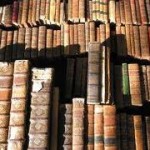We continue our educational series on collecting rare books with some additional insights specific to the storage of rare, old, antiquarian and vintage books. In our introductory write-up entitled “Rare Books 101,” we provided a summary of topics pertinent to book collecting to get one familiar with the terminology and broad aspects of the art or science of collecting and trading rare antiquarian books.
Once you have amassed some quantity of books whether rare or not, and intend to keep them for the longer term perhaps in a home library stored for later generations, or in the shelves of your trader shop, preservation becomes critical. Storing a rare book is inevitably a bit more difficult, due to the specific value associated with the item as well as additional potential concerns such as old age, accessibility, and so forth. Indeed, storing books involves aesthetical as well as environmental factors.
Storing on shelves. It is important that large size (e.g. Folio approx 12×15”) books be placed and stored flat on the available shelves. This will prevent any deformation and tearing of larger pages due to the book’s greater weight and size. Smaller books however, (e.g. Octavo approx. 6×9”) should be stored upright, at a 90-degree angle to the shelf, and should be supported on each side either by other books or by special book supporters. It is important to ensure that large parts of the covers are not exposed, as well as not covered with other books, so that the effect of fading or “sunning” as is commonly referred of the exposed area is unquestionably avoided. Unprotected exposure to the sun in this manner will swiftly deem the book less attractive, and thus less valuable. Furthermore, they should not be packed too tightly, as this may affect the binding of the book pages and can cause damage while attempts are made to retrieve the book from the shelf. Special care should certainly be taken when removing a book from a shelf to avoid pulling the spine too hard, thus causing harm to the hinge or a tear to occur at the head of the book’s spine.
Lighting: Without question, rare and old books should be kept away from direct lighting. Ultra violet rays bleach the paper and spine of a book, or any other part that is exposed, turning it an undesirable shade of yellow. Covering a book in transparent plastic prevents damage not only from excess handling but also from excess sunlight exposure. Mylar (transparent plastic) covers could be thought of as acting much like sunglasses for books. UV rays can also increase the acidity of paper causing foxing (yellow-brown splotches) and can thereby accelerate the rate of book decay.
Temperature: It is vital to control the temperature of the environment in which the books are stored, keeping the degree of the air at a fixed constant. It is also important to keep the books away from sources of direct heat such as stoves, fireplaces and radiators, which can quickly heat books up and cause irreparable damage. Temperatures that are either too high or too low can result in many damaging and sometimes devastating effects. If the temperature is too high for instance, there is a possibility that leather covers will crack. Low temperatures are not favorable either, as they enable the growth of mold to flourish. The right temperature in which the rare books should be stored then should be 60-66 degrees Fahrenheit (16-19 degrees Celsius). Having a thermometer in the room near the books, will allow you to monitor temperature fluctuations and more easily take the appropriate actions.
Humidity: Adequate control of humidity is equally as important as temperature is and should be treated as such. Rare books should be kept and stored away from sources of moisture, and certainly away from water pipes. The moisture conditions should be such that would hinder the growth of micro organisms, such as mold and mildew, which slowly eats away at and destroys books. The relative humidity in the room can be measured with a hygrometer, and should be kept as constant as possible within the range of 45%-60%.
Cleaning: Once the books are stored and the room conditions are controlled, they should, from time to time, be cleaned. Cleaning the books from dust should be done regularly. This will prevent dust accumulation, as dust is the food source of mold, which slowly destroys the books by staining both the inside paper as well as the cover. Books should be cleaned carefully and methodically. To do this properly, you must first remove the book from shelf, and, holding the book closed use a soft cloth to brush dust away from the cover, as well as from the spine and textblock. It goes without saying that dusting the books should be done in an area which is far removed from the storage area to avoid transferring the dust being removed to other books in the flying dust’s path. Investing in a small, portable vacuum cleaner and always checking for any unusual dirt and droppings of mice will greatly aid you in taking the appropriate actions.
In short: Move the books around. Keep them away from ultra-violet light. Make sure that they stand erect. By adhering to these simple guidelines, you will find that preserving and protecting your priceless rare, old and antiquarian books will be both simple and rewarding, as each delightful volume is continuously enjoyed for generations to come.

{ 0 comments… add one now }